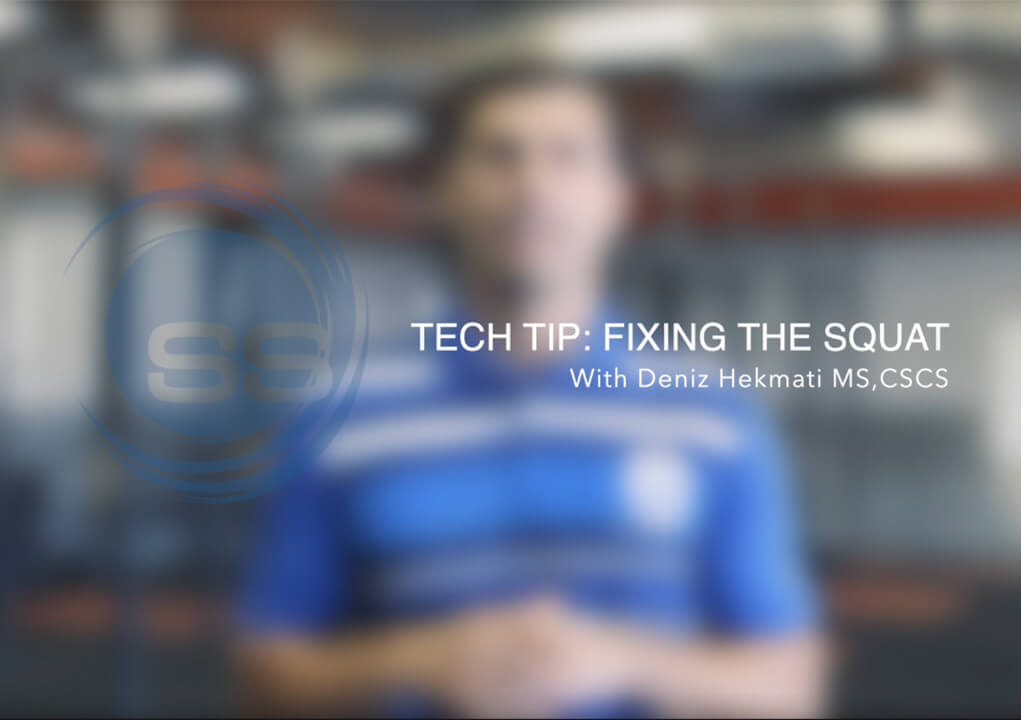Swimmer Strength Tech Tip: Fixing the Squat by Improving Range of Motion

Contributed by Deniz Hekmati – Strength & Conditioning Specialist, Sport Scientist
In this last squat tip, we want to highlight that improving range of motion in the lower extremities is so critical yet highly underestimated. Just by engaging in daily activity to improve range of motion might fix a poor squat.
Watch video
First, swimmers tend to have tight calves and limited dorsiflexion from the ankle. Improving this will help distribute the weight more evenly on the feet at the end range of the squat.
Some quick ways of improving dorsiflexion are Ankle Rocks – and we can do these against a wall or with a band distraction to manipulate the ankle structure more, where the objective is to keep the heel on the ground and move the shin towards he toes by flexing the knee to rock the body forward. In this dynamic rocking position, I encourage a few maximal dorsiflexion repetitions for 2-3 seconds to get some activation from the anterior tibialis muscle. We are essentially pointing the toes upward towards us during the end range of the ankle stretch.
Next, swimming is such a hip dominant sport that the hip flexors and quads get exceptionally tense. They might contribute to many swimmers feeling the movement being blocked at the end range. So, stretch the hip flexors and quads thoroughly, and don’t settle there. Open up the hips and legs completely – think gymnast! Doing the pigeon and butterfly stretch to opening up the groin will additionally help the swimmers that keeps pointing the toes straight out to the side. If we spend a few minutes per area on a daily basis, we’ll start seeing some noticeable change in the squatting techniques.
There are a few tricks we can include to facilitate range of motion using bands, mobility balls and foam rolls.
Evidently, restrictions start building up in very young swimmers – I’m talking 10-12 year olds. Their limbs are growing so fast, and we’re so worried about working these kids that we tend to overlook stretching them. Naturally over time, these restrictions accumulate and movements start looking worse and worse and will eventually lead to injury. As you can tell, there is so much to be said about a squat, so want I to finish by quickly scanning through the most common restrictions seen with our swimmers.
Now, if the swimmer is experiencing pain when executing the squat that is beyond a soreness or a restricted feeling, such as a pinch in the hip or knee, or some sort of tingling – that is a sign to go see a qualified physical therapist.
Tip of the week: fix your restrictions and do it on a daily basis, ideally before practice. Next week, we visit the 3 healthiest core exercises we can do.
See more videos from Swimmer Strength Coach Deniz Hekmati:
Swimmer Strength Tech Tip: Abdominal Bracing
Swimmer Strength Tech Tip: Strength and Dryland Technique Matters
Swimmer Strength Tech Tip: Age to Start Dryland Training or Strength Training
Swimmer Strength Tech Tip: Squat Problems
Swimmer Strength Tech Tip: Performing the Squat
For more information, subscribe to the Swimmer Strength newsletter found on our website swimmerstrength.com.
Note: All swimming and dryland training and instruction should be performed under the supervision of a qualified coach or instructor, and in circumstances that ensure the safety of participants.



